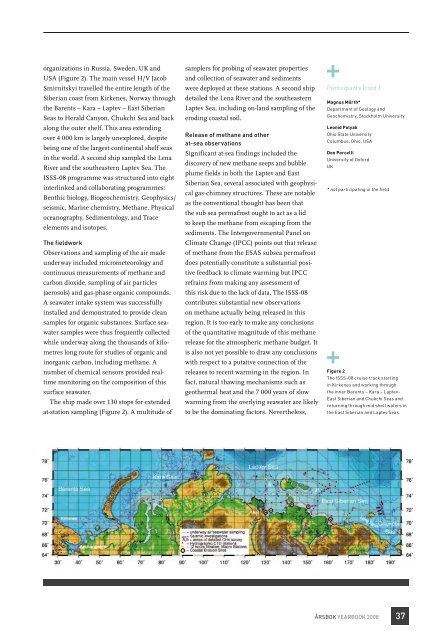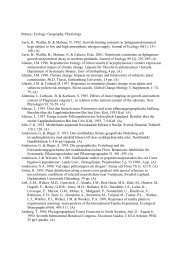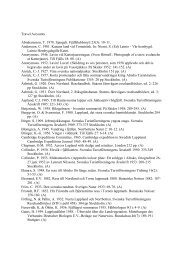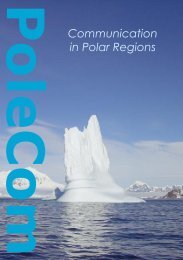Ladda ner årsbok 2008 (6,5 MB) - Polarforskningssekretariatet
Ladda ner årsbok 2008 (6,5 MB) - Polarforskningssekretariatet
Ladda ner årsbok 2008 (6,5 MB) - Polarforskningssekretariatet
Create successful ePaper yourself
Turn your PDF publications into a flip-book with our unique Google optimized e-Paper software.
organizations in Russia, Sweden, UK and<br />
USA (Figure 2). The main vessel H/V Jacob<br />
Smirnitskyi travelled the entire length of the<br />
Siberian coast from Kirkenes, Norway through<br />
the Barents – Kara – Laptev – East Siberian<br />
Seas to Herald Canyon, Chukchi Sea and back<br />
along the outer shelf. This area extending<br />
over 4 000 km is largely unexplored, despite<br />
being one of the largest continental shelf seas<br />
in the world. A second ship sampled the Lena<br />
River and the southeastern Laptev Sea. The<br />
ISSS-08 programme was structured into eight<br />
interlinked and collaborating programmes:<br />
Benthic biology, Biogeochemistry, Geophysics/<br />
seismic, Marine chemistry, Methane, Physical<br />
oceanography, Sedimentology, and Trace<br />
elements and isotopes.<br />
the fieldwork<br />
Observations and sampling of the air made<br />
underway included micrometeorology and<br />
continuous measurements of methane and<br />
carbon dioxide, sampling of air particles<br />
(aerosols) and gas-phase organic compounds.<br />
A seawater intake system was successfully<br />
installed and demonstrated to provide clean<br />
samples for organic substances. Surface seawater<br />
samples were thus frequently collected<br />
while underway along the thousands of kilometres<br />
long route for studies of organic and<br />
inorganic carbon, including methane. A<br />
number of chemical sensors provided realtime<br />
monitoring on the composition of this<br />
surface seawater.<br />
The ship made over 130 stops for extended<br />
at-station sampling (Figure 2). A multitude of<br />
samplers for probing of seawater properties<br />
and collection of seawater and sediments<br />
were deployed at these stations. A second ship<br />
detailed the Lena River and the southeastern<br />
Laptev Sea, including on-land sampling of the<br />
eroding coastal soil.<br />
Release of methane and other<br />
at-sea observations<br />
Significant at-sea findings included the<br />
discovery of new methane seeps and bubble<br />
plume fields in both the Laptev and East<br />
Siberian Sea, several associated with geophysical<br />
gas-chimney structures. These are notable<br />
as the conventional thought has been that<br />
the sub sea permafrost ought to act as a lid<br />
to keep the methane from escaping from the<br />
sediments. The Intergovernmental Panel on<br />
Climate Change (IPCC) points out that release<br />
of methane from the ESAS subsea permafrost<br />
does potentially constitute a substantial positive<br />
feedback to climate warming but IPCC<br />
refrains from making any assessment of<br />
this risk due to the lack of data. The ISSS-08<br />
contributes substantial new observations<br />
on methane actually being released in this<br />
region. It is too early to make any conclusions<br />
of the quantitative magnitude of this methane<br />
release for the atmospheric methane budget. It<br />
is also not yet possible to draw any conclusions<br />
with respect to a putative connection of the<br />
releases to recent warming in the region. In<br />
fact, natural thawing mechanisms such as<br />
geothermal heat and the 7 000 years of slow<br />
warming from the overlying seawater are likely<br />
to be the dominating factors. Nevertheless,<br />
Participants (cont.)<br />
magnus mörth*<br />
Department of Geology and<br />
Geochemistry, Stockholm University<br />
leonid Polyak<br />
ohio State University<br />
Columbus, ohio, USA<br />
don Porcelli<br />
University of oxford<br />
UK<br />
* not participating in the field<br />
Figure 2<br />
The ISSS-08 cruise track starting<br />
in Kirkenes and working through<br />
the in<strong>ner</strong> Barents – Kara – Laptev-<br />
East Siberian and Chukchi Seas and<br />
returning through mid shelf waters in<br />
the East Siberian and Laptev Seas.<br />
åRSBoK YEARBooK <strong>2008</strong><br />
37








